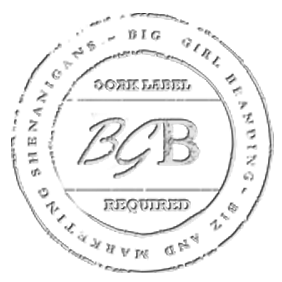This is a guest post by Danny Iny, and since I’m a big fan of references to pop culture on BGB, and drawing parallels between them for your biz, Danny sweet-talked his way into writing for you guys. 😉
No really it’s just a damn good post, no sweet talking required. Let’s make him feel welcome by starting a bit ‘o conversation shall we?
So many things happen on Wisteria Lane!
Not only are classic storylines of boy meets girl intertwined with conspiracies, secrets, murders and more, but each of the Housewives have their own drama unfolding, so that when one’s secret is revealed, there are still three others left to explore.
And of course, by the time the others have worked themselves out, the first one has a whole new storyline under way!
You may go for a snack during the commercials, or pause the DVR when the phone rings, but you keep coming back – to finish the episode, and to watch the next one – because there’s always something that’s still going on, and you want to know how it turns out.
Wouldn’t it be nice if you could generate this sort of loyalty on your blog, or with your audience?
The Magic of Open Loops – from Zeigarnik to Hemingway
What gives a good TV drama or soap opera the power to draw us in like that?
The answer lies with a phenomenon that psychologists call the Zeigarnik Effect, named after Bluma Zeigarnik, the Russian Gestalt theorist. In a nutshell, it is the feeling of mental tension and unbalance that is caused by uncompleted tasks.
It’s part of our mental wiring to want to know “how it ends” – part of our natural curiosity that drives us to ask questions like “why?” and “what next?”
The best storytelling takes advantage of this effect to draw you in. Take, for example, the shortest story ever written, by Ernest Hemingway :
“For sale: baby shoes. Never worn.”
The story is only six words long, but it grips us immediately. Why were they never worn? What happened? We imagine possible scenarios, and want to know which one is the true cause.
Open Loops in Your Writing: Stories and Narrative
The operative question, now, is how to make use of the Zeigarnik in our writing and storytelling (and selling, but that’s a bit later).
It’s all great in theory, but flies in the face of another piece of good writing advice, which is to be clear and to the point – the real risk with open loops is that you might just end up with sloppy, rambling text!
The answer is to put the loops in the right places – there are specific spots within a body of text that are natural “stopping points”, and those are the places where you need to have a loop open to make sure that your audience comes back for more.
Here are the most important spots to open a loop in writing and storytelling (using blog posts as an example, but it’s almost exactly the same for most other types of writing), and examples of how I did it with this post:
The headline.
According to Sean D’Souza of Psychotactics, there are three key ingredients to a successful headline. Chief, in my opinion, is that the headline must evoke curiosity. Take the headline of this post: “Desperate Housewives on Writing, Storytelling, and Selling” – if it didn’t make you wonder “Hmmm… what do desperate housewives have to say about writing, storytelling, and selling?” then you wouldn’t be reading this post now.
Before the MORE tag on your blog posts.
When you visit a blog’s homepage, you don’t see the whole post – just the first section, usually. The job of that first section is to get you interested enough to read the rest of the post. This post’s opening section concluded with “Wouldn’t it be nice if you could generate this sort of loyalty on your blog, or with your audience?” – in other words, you don’t yet know how to do it, but if you keep reading you’ll find out. Open loop.
At the end of each section, before the next heading.
This is particularly true with longer blog posts, articles, and books (in which case this would be a new section or chapter). It is an obvious place to stop, because we try to conclude our ideas and trains of thought before moving on to something else. But then, where’s the cliffhanger? The suspense? It is important to tie what you just said into what you’re about to say, to keep people going.
Sub-headers, starting a new section.
This ties back to the last item. When we finish a section, if we’re “on the fence” about continuing, we often read the next heading to see if it grabs us. You have to make sure that it does, by piquing interest, and promising benefits.
At the end of the post.
This is an often-forgotten part, but remember that after reading a post, you want people to take an action. It could be to pick up the phone and call you, or subscribe to your newsletter, or – as is the case with this post – it is to leave a comment. This is my guest debut on Big Girl Branding, and I’m nervous about making a good impression. Will you encourage me by leaving a comment, or will you just leave me sitting at my computer in the dark, nervously tapping “refresh” on the blog and my inbox? 😉
The Zeigarnik effect doesn’t just apply to writing and storytelling, either. It applies to sales – making more of them, and increasing the total dollars that we make from our customers. Here’s how…
More Sales, Too – Housewives Style!
This doesn’t just apply to writing – it also applies to deal management and fulfillment.
The way in which too many people offer services is to close a deal, and then fulfill the deal. Only after the deal is done do some of us have the gall to meekly ask whether there is anything else that we might be able to do for the client.
Instead, while providing the services, we should be keeping our ears open for clues that there is something else that the client might need. We should explore it a bit in conversation. Enough so that we know what they want and how much they want it, and enough for them to consider us as possible choices to provide the service – but not enough to actually try to close the deal. That happens later. For now, just prepare a swipe file of issues that this client might need help with in the future.
When the first mandate is coming to a close, that’s the time to bring up all of the issues that you put in your swipe file. Casually mention them to feel out whether they’re still relevant, and before the mandate is completed (but after the client knows that it will be completed to their satisfaction) – that is the best time to ask them how they would like you to work with them on this new project. While the loop is still open!
So let’s see… I’ve explained how the Zeigarnik effect – as seen on Desperate Housewives and other good TV dramas – applies to writing, storytelling, and selling. So that closes all the loops… except…
Sitting Alone In the Dark…
This is my guest debut here, and I want to hear what you think. Did you like the post? Did it make you think? Did it give you an idea to apply in your work? Please leave me a comment and tell me!
So, if you like this post… comment already! And share it of course. I love that too. Just don’t leave Danny sittin’ in the dark, please! I’d feel totally guilty.

